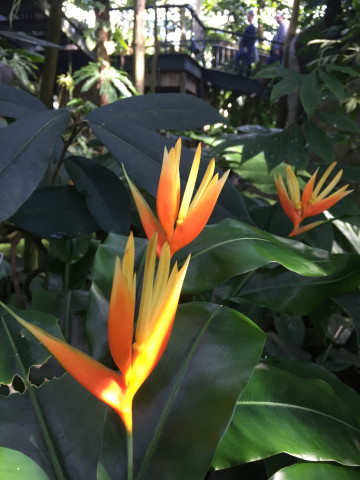Our Environment: “Defying Gangs for Urban Beauty” By Scott Turner
Sunday, February 24, 2019
As kids growing up in the Bronx of the 1960s and 70s, we would occasionally tromp east along Fordham Road to the New York Botanical Garden (NYBG), avoiding any number of street gangs and other dangers to enter the greenery through a bent rail in the property’s wrought iron fence.
Back then, relatively few folks visited the NYBG to stroll the grounds and greenhouses, as much as they did to find mugging targets or items to steal.
In my 20s, during the 1980s, I lived just three blocks from the NYBG, which I typically accessed via a tunnel under the commuter rail line. That passageway was dark, damp and dangerous. When news spread of an assault within that tunnel, I walked the extra block or two to reach the flowers and plants in a decade where a deserted NYBG looked like hardly anyone knew it was there.
GET THE LATEST BREAKING NEWS HERE -- SIGN UP FOR GOLOCAL FREE DAILY EBLASTThe tunnel is no longer open, and as far as I can tell, no deathtraps exist to reach one of the most bucolic landscapes of New York City. So, when Karen and I looked to escape to somewhere warm, humid and colorful in mid-February, we drove the 170 miles to visit the NYBG.
When you haven’t been to a place in 35 years, you tend to think of it as you last saw it: empty and somewhat sinister. But that’s not what we found.
In the bright sun on a chilly, cloudless day, we encountered a revitalized and lively National Historic Landmark full of other visitors, and rich with spiffy facilities that I didn’t recall such as the Levy Visitor Center, Pine Tree Café, and Discovery Center.
We headed straight for the spot to revive our winter-weary souls (and skins)—the Enid A. Haupt Conservatory, which the NYBG calls “a stunning example of Victorian-style glasshouse artistry.” The conservatory contains room after room of “lush tropical rain forests, cactus-filled deserts, curated displays of palms from around the world, aquatic and carnivorous plants, and much more.”
The houses were moist, green and fragrant with a smell of spring and summer. Orchids provided bursts of color. Fruits, such as cacao, offered bounty at which to marvel.
The textures, shapes, sizes, light and spaces, led me to want to touch everything. However, there was no touching the cycads, ferns and other plants, according to the rules.
Just as stunning as the clammy tropical houses were those of bright sun and dry sand that accommodated desert plants. Here, you didn’t want to handle the vegetation. Much of it, such as the sharp teeth of agave or the needle-like spines of saguaro, were better off observed than touched.
Even in winter, the NYBG grounds looked picture-postcard perfect, such as the conifer arboretum and its evergreens of unusual trunks, branching patterns and foliage, which we strolled through on our way to the Steere Herbarium on the second floor of the Mertz Library and Art Gallery.
A herbarium is a “systematically arranged collection of dried plants.” It was open on the day we visited, as part of “#plantlove” weekend at the NYBG,
Steere Herbarium contains some 7.8 million specimens, making it the second-largest herbarium in the world, notes the NYBG.
On display for us to touch and learn about were dozens of “pressed” plants from around the world. One exhibition featured seaweed and ferns collected by women, during the Victorian era. Among the items, my favorite was a book, published by someone named Jennie Knox in 1888. Her name in the front of the volume was spelled out in delicate algae lifted deftly and dried from the Pacific Ocean.
The world of plants that we found inside and outside at the NYBG immersed us in nature’s beauty and diversity.
Were we transported elsewhere by the experience? You bet, and it wasn’t to the bad old 70s and 80s. It was to the present, and “now” felt much better than “then.”
This week, the first blossoms of snowdrops are likely out on the NYBG grounds, but I can tell you firsthand that my old stomping grounds are already in full bloom.
Scott Turner is a Providence-based writer and communications professional. For more than a decade he wrote for the Providence Journal and we welcome him to GoLocalProv.com.
Related Articles
- Our Environment: “Breeding Ground of the Great-Crested Flycatcher” By Scott Turner
- Our Environment: “The Amazing Blackstone” By Scott Turner
- Our Environment: “A Morning Search for Evening Grosbeaks,” By Scott Turner
- Our Environment: “Sharp, Explosive, Chink” by Scott Turner
- Our Environment: Fall Fruit and Vegetables in New England, by Scott Turner
- Our Environment: “Psithurism” By Scott Turner
- Our Environment: “The Beauty of Winter Gray” By Scott Turner
- Our Environment: “Tracking the Bird Count” By Scott Turner
- Our Environment: “RI Environmental Bucket List Item” By Scott Turner
- Our Environment: “East Side Sunrise” By Scott Turner
- Our Environment: “The New England Sunset” By Scott Turner
- Our Environment: “Missing Species in RI” By Scott Turner
- Our Environment: “Robins Descend in the New Year” By Scott Turner
- Our Environment: “Fuzzy Orange-and-Black Woolly Bear Caterpillar” By Scott Turner






